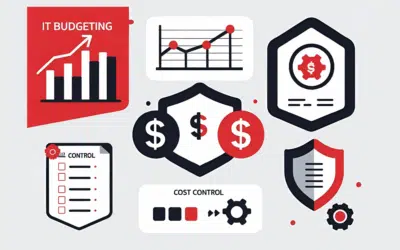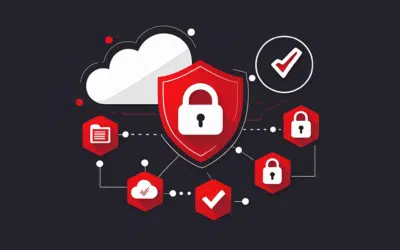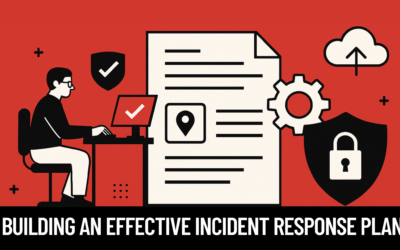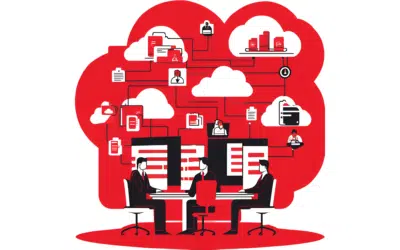The threat of cybercrime continues to grow each year, and small businesses are particularly vulnerable. The latest cybersecurity trends indicate that organizations of all sizes must remain vigilant in order to protect their valuable data. In this article, we’ll cover the four of the most important areas for small businesses to focus on when it comes to cybersecurity: ransomware, training remote employees, password tools, and disaster recovery & backups.
Ransomware
Ransomware is a type of malicious software (malware) that cybercriminals use to gain unauthorized access to an organization’s systems and data. Once the ransomware has been installed on a computer, it will encrypt the victim’s files and demand a ransom payment in order for the user to regain access. It can be spread through malicious emails, malicious websites, and software downloads. Ransomware is becoming more of an issue for small businesses as cybercriminals are increasingly using this method to extort money from organizations.
Protecting your small business from ransomware
There are several steps you can take to protect yourself against ransomware attacks. First, make sure your website and systems are regularly updated with the latest security patches. Additionally, ensure your employees are trained to recognize ransomware and other malicious emails. Finally, invest in a reliable security solution that can detect and block incoming ransomware attempts.
Employee Training
As more and more companies embrace work-from-home and hybrid work environments, the needs of employees when it comes to security are changing. Employees are often the weakest link when it comes to cybersecurity. From angry employees stealing intellectual property to employees falling victim to scams or making a simple mistake, employees must be considered as a key component of your organization’s security posture. Uninformed employees can easily fall victim to cybercriminals by clicking on malicious links, downloading malware-infected files, or exposing sensitive information online. In addition, they may not be aware of the latest security protocols and best practices for protecting data, leaving them vulnerable to attacks. As a result, employee security training is essential when it comes to preventing cyberattacks, particularly for companies with remote workforces.
To help protect your business from potential threats, it’s essential to provide ongoing employee security training. This should include providing employees with the knowledge they need to identify and avoid malicious emails and websites, as well as teaching them best practices for keeping data secure while working remotely. Additionally, organizations should invest in a comprehensive security solution that provides visibility into employee activities and detects suspicious behavior.
Best practices for training employees to protect your company
Make sure all your employees are familiar with the basics of cybersecurity and understand which threats to look out for. Set up a training program that regularly covers best practices for password protection and other key aspects of cybersecurity. This will help to ensure your entire staff is up-to-date with the latest information.
Password Managers
Password managers can be an invaluable asset in protecting your data from unauthorized access. Make sure you have strong password requirements for all of your employees and consider investing in a password manager that can help protect your accounts. Password managers are designed to generate complex passwords and store them securely, making it more difficult for hackers to compromise your systems. A password manager stores all of your passwords and other sensitive data in one place, allowing you to easily remember them with just one master password.
Choosing a password manager
When it comes to choosing a password manager, there are several important factors to consider. First and foremost, security is paramount. A good password manager should offer robust encryption and multiple layers of authentication. It should also use secure protocols for data transmissions, such as TLS or SSL, to ensure that any sensitive data remains protected from interception. Additionally, look for features such as two-factor authentication, automatic password rotation, and dark web monitoring to further secure your accounts.
Disaster Recovery and Data Backup
Finally, ensure you have a comprehensive disaster recovery and backup plan in place. Disaster recovery (DR) and backup solutions are essential for any small business. Disaster recovery is the process of recovering data in the event of a system or hardware failure, while data backup is the regular replication of important files and information to an off-site location.
A comprehensive disaster recovery plan should include redundancy strategies such as replicating data to multiple storage locations, setting up failover systems, and regularly testing backups to ensure the integrity of the data. Make sure your plan covers procedures for responding to cyberattacks or data breaches. Regular backups should be stored off-site so that if your systems are hacked, you can quickly restore them to a working state. Additionally, make sure you have plans for how to respond in the event of a cyberattack or data breach. By having a clear set of procedures and protocols in place, you’ll be better equipped to handle any potential security incidents.
By investing in a comprehensive backup and disaster recovery solution, businesses can be prepared for any unexpected disasters that may arise. This will help to ensure that any data loss or system outages can be remedied quickly and seamlessly. A solid DR plan is essential for any business that relies on technology, as it helps protect against potential losses that could occur due to hardware failure, natural disasters, or cybercrime.
Choosing a disaster recovery solution
When it comes to choosing a disaster recovery solution, small businesses have many options. However, the most important thing to consider is how the solution will protect your data in the event of an emergency.
One common approach is to use cloud-based backups, which are stored off-site and can be quickly accessed if needed. When choosing a cloud-based solution, make sure to research the provider’s security features and ensure that your data is encrypted during transit and storage. Additionally, consider the provider’s recovery time objectives (RTOs) and recovery point objectives (RPOs) before committing to a service.
These four areas—ransomware, training remote employees, password tools, and disaster recovery and backup—are the most important for small businesses to consider when it comes to cybersecurity. By taking steps to address each of these areas, you can help protect your data as well as maintain compliance with relevant regulations.
Are you ready to start improving your organization’s security? Get in touch with the team at Axxys Technologies today. Our team of experienced security professionals can design and implement a cybersecurity solution that fits your business needs as well as it fits your business budget. Contact Axxys Technologies today.








